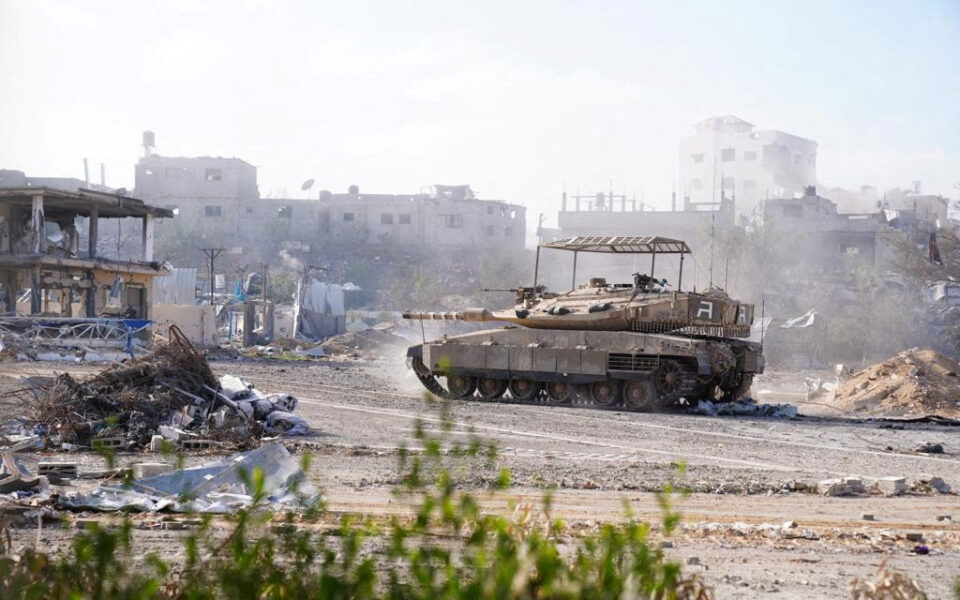General Hacohen tells Kathimerini Israel had ‘no choice but to enter Gaza’

What tactics does Israel use in the urban environment of Gaza and what difficulties do the armed forces face in the Gaza Strip? These questions were answered by the former commander of the northern army of the Israeli Defense Forces (IDF), and member of the Israel Defense and Security Forum, Major General (ret.) Gershon Hacohen. In an interview with Kathimerini, the man who oversaw the disengagement of Israeli forces from the Gaza Strip in 2005 analyzes the strategic thinking and operational challenges faced by armed personnel entering the hostile environment.
‘We are trying to clean off all northern side of Gaza and to destroy the fortress that is hidden in Gaza City’
According to General Hacohen: “We have no choice but to enter Gaza. All postmodern warfare is taking place in urban locations. We cannot bypass the city and the main battle necessarily must be in that city, because the enemy is there. The leaders of the enemy are hiding there, either under the Al-Shifa Hospital in the underground or in other places. So, if we do not enter the city, Gaza will become a ‘mythos,’ a heroic battlefield like Leningrad, which will enable them to claim that they overcame the IDF, which did not dare to enter the city. He adds: “What we are facing in Gaza is far away from being guerrilla [warfare]. It is a new form of warfare that emerged in Afghanistan in order to defeat huge modern military organizations. From our side, we are using a lot of techniques, which we cannot reveal right now.”
What puzzles many military analysts is the use of tanks in the dense urban parts of Gaza. The retired officer and former commander of the IDF Military Colleges was asked about the strategic importance of bringing heavily armored vehicles into the unstable Gaza field. As he explains: “There is no other way than sending the armored vehicles into Gaza. The infantry that is not protected by armored vehicles will not survive. They would be attacked by mortars, rockets, RPGs, snipers and TNT charges. They will not survive an hour. The only way to survive is by protecting the forces inside excellent armored vehicles.”
The first images that reached the news agencies show Israeli tanks surrounding the Palestinian territory, with efforts to completely cut off the northern part of the enclave continuing. When asked to respond to the strategic objectives of this action, General Hacohen was clear: “We are trying to clean off all northern side of Gaza and to destroy the fortress that is hidden in Gaza City. Gaza City is not only a militaristic object, it is a symbol, it is the capital of Hamas.” Asked about Israel’s action to cut off the supply of drinking water and electricity to the Palestinian territory, he explains: “This action is bringing a lot of constraints and difficulties for Hamas. Therefore, they struggle so much to get deliveries of gasoline because they need to create electricity by themselves. You cannot really live in the tunnels without getting oxygen, without light, and for that they need electricity. So, it is a part of the conditions for achieving victory, to not deliver them the necessary conditions for going ahead. I have to mention that I do not know even one example of a nation that came to fight with another nation and all electricity came from one side to the other.”
International sources put the number of Hamas terrorists at 30,000-40,000, with many experts arguing that it is impossible to eradicate Hamas, as the Israeli prime minister promises. General Hacohen stresses: “We are not even dreaming of killing all of them. It is quite impossible. But we are trying to kill part of them that will create the political and strategic impact that we desire.”
At the end of our conversation, the veteran general summarized that “Israel’s disengagement from Gaza in 2005 was a strategic mistake and that Israel’s goal is the unconditional surrender of Hamas.”





